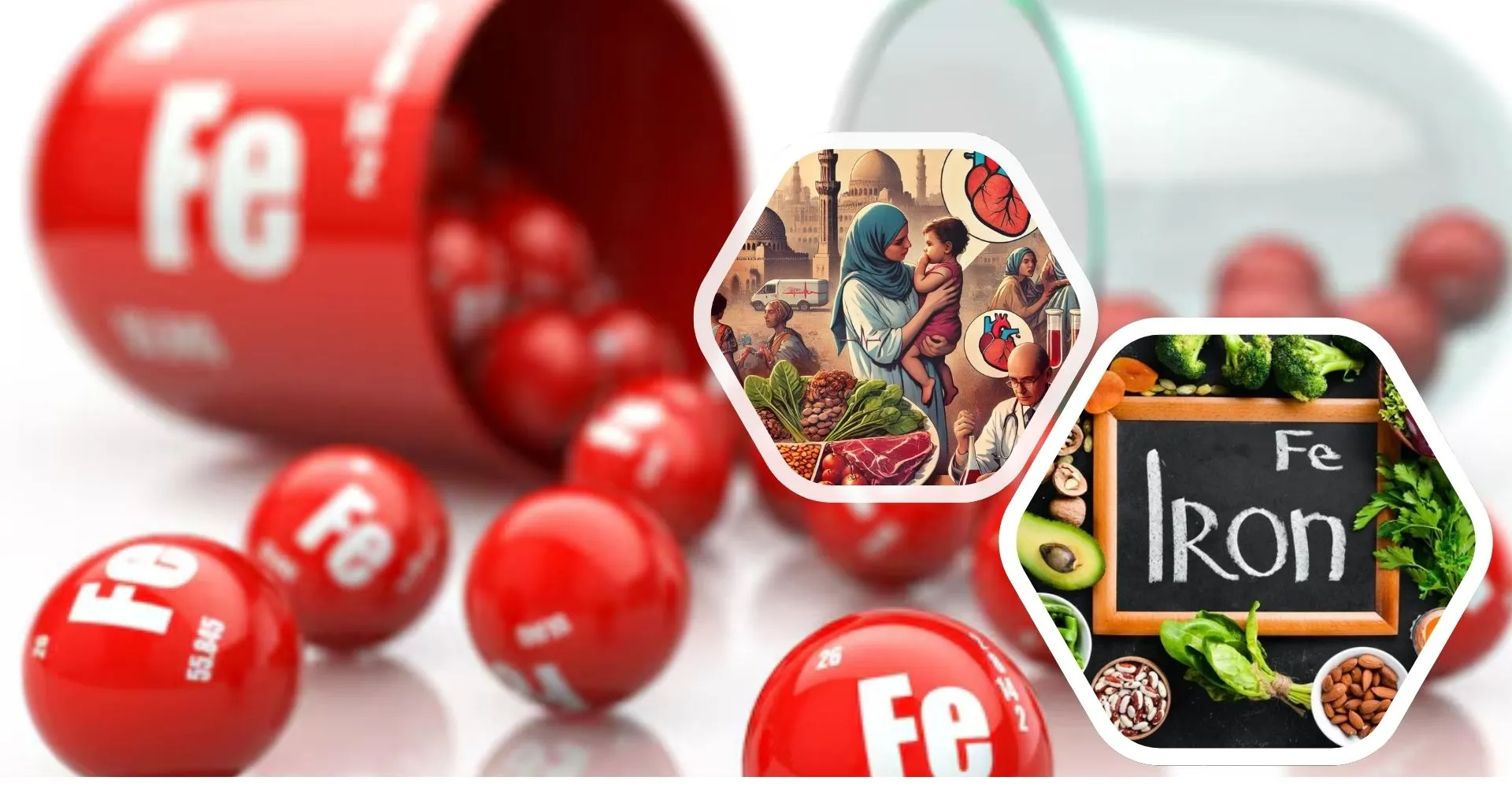The Severity of Iron Deficiency Anemia in Egypt- A Growing Concern
Iron deficiency and anemia are increasingly becoming critical health issues in Egypt, sparking concern among healthcare professionals and policymakers alike. Emerging data indicates a troubling rise in these conditions, which not only affect individual health but also have broader socio-economic implications.
What are the underlying causes of this surge, and how can they be effectively addressed through innovative interventions?
With Egypt’s unique nutritional landscape and varying socio-economic strata, understanding the multifaceted dimensions of iron deficiency and anemia is imperative. The implications are far-reaching, impacting everything from workforce productivity to community health standards. Recent studies highlight significant deficiencies in dietary intake and healthcare access, compounding the challenge.
As industry experts delve deeper into this growing problem, novel strategies are being explored to mitigate its impact. Leveraging cutting-edge research and quality-focused solutions will be key in reversing this trend. Join us as we uncover the latest findings, explore potential solutions, and strive for excellence in combating iron deficiency and anemia in Egypt.
The clock is ticking, and the need for innovative, expert-driven action has never been more urgent.
The World Health Organization (WHO) has identified iron deficiency anemia as a significant public health problem in the country, with far-reaching consequences for individuals and society as a whole.
By shedding light on this pressing health concern, the article aims to raise awareness and highlight the need for effective strategies to address anemia and iron deficiency in Egypt.

The Burden of Iron Deficiency Anemia in Egypt
Prevalence Rates
Iron deficiency anemia has become a significant public health concern in Egypt, affecting a substantial portion of the population. Recent studies estimate the prevalence of iron deficiency anemia in Egypt to be around 25-30% among the general population [1]. The condition has a particularly severe impact on women and children.
Among children, the prevalence of anemia has shown an alarming increase. Between 2000 and 2005, the percentage of Egyptian children aged 12 to 36 months with anemia (defined as hemoglobin concentrations <11 g dL−1) rose from 37.04% to over 52% [2]. This rise occurred alongside changes in food consumption patterns and increases in childhood diarrhea.
The prevalence of anemia varies across different age groups and regions. For preschool children, the rate stands at 39.6%, while school children and adolescents both show rates of around 35%
[3]. Rural areas and frontier governorates are especially affected, with anemia being most common among children aged 9-11 months, reaching 49% [4].
Economic Costs
The economic burden of iron deficiency anemia in Egypt is substantial. In 2009, the economic cost of malnutrition in Egypt was estimated at 20.3 billion Egyptian pounds (EGP) due to child undernutrition [4]. This significant cost stems from the condition’s strong negative impact on learning, education, and future productivity.
Iron deficiency anemia has far-reaching economic consequences, including decreased productivity, increased healthcare costs, and reduced educational attainment [1]. These factors contribute to a cycle of poverty and underdevelopment, hindering Egypt’s economic growth.
Social Implications
The social implications of iron deficiency anemia in Egypt are profound. The condition has been linked to increased risk of maternal mortality, impaired cognitive development in children, and reduced quality of life for those affected [1]. It has a particularly severe impact on children’s cognitive and physical development, potentially limiting their future opportunities and social mobility.
Anemia also remains a prevalent problem among Egyptian mothers, with one-quarter of ever-married women being anemic [4]. This has implications for maternal health and the well-being of future generations, as maternal anemia can lead to complications during pregnancy and childbirth.
As iron deficiency has become a huge health issue, West Bengal Chemical Industries Limited manufactures various iron salts to address this growing concern. Their products aim to contribute to the fight against iron deficiency anemia in Egypt and improve the overall health of the population.
Dietary Patterns and Iron Intake
Traditional Egyptian Diet
The traditional Egyptian diet has been shaped by the country’s unique ecology and has remained relatively stable for millennia. Bread, made from high-extraction wheat flour, holds a central place in Egyptian meals [5]. Cereals and legumes form the foundation of the diet, providing the majority of calories and proteins [5]. This dietary base has been complemented by small amounts of dairy products, fresh dark green leafy vegetables, and occasional consumption of eggs, poultry, fish, and red meat [5].
Changes in Food Consumption
Recent years have seen significant changes in Egyptian dietary habits, largely due to urbanization and changing lifestyles. There has been a shift towards more sedentary lifestyles and alterations in the dietary and economic context [6]. New urban lifestyles have led to reduced consumption of traditional foods and increased intake of fast food and sugar-sweetened beverages [6]. These changes have contributed to the high mean BMI of Egyptian women, which is one of the highest worldwide [6].
Iron-Rich Food Sources
The Egyptian diet includes both heme and non-heme iron sources. Heme iron, found in meat, fish, and poultry, has a higher absorption rate of up to 30% [7]. Non-heme iron, present in plant-based foods, has a lower absorption rate of 2-10% [7]. The traditional Egyptian diet relies heavily on non-heme iron sources, with an average daily intake of 12.6 ± 4.3 mg of non-heme iron out of 13.8 ± 4.6 mg total iron consumed [6].
To address the growing concern of iron deficiency, West Bengal Chemical Industries Limited manufactures various iron salts. These products aim to contribute to the fight against iron deficiency anemia in Egypt and improve the overall health of the population.

Socioeconomic Factors Influencing Anemia Rates
Education Levels
Education has a significant impact on anemia rates in Egypt. Studies have shown that children of mothers with no education are more likely to be anemic compared to those whose mothers have some education [2]. In urban areas, the prevalence of anemia is nearly six times higher among illiterates than those with secondary and above educational levels [8]. Similarly, in rural areas, the odds of anemia are 3.6 times higher in illiterates and 2.69 times higher in those with primary school education compared to those with secondary and above educational levels [8].
Income Disparities
Anemia serves as an indicator of socioeconomic disadvantage, as it is inversely related to household socioeconomic status in developing settings [9]. The prevalence of total and severe anemia is highest among the lowest socioeconomic groups. For children aged 6-59 months, the prevalence of total anemia in the lowest socioeconomic group is 59.80%, compared to 47.46% in the highest socioeconomic group [9]. Similarly, for nonpregnant women aged 15-49 years, the prevalence is 37.58% in the lowest socioeconomic group and 34.42% in the highest [9].
Urban vs Rural Differences
Significant disparities exist between urban and rural areas regarding anemia rates. In Egypt, the prevalence of anemia is higher in rural areas, with 46.6% of rural residents affected compared to 20.1% of urban residents [8]. Children residing in rural households in Upper Egypt, especially those without water and sanitation facilities, are significantly more likely to be anemic than urban children in other governorates with better facilities [2].
However, it’s worth noting that some studies have found no significant difference in anemia prevalence between urban and rural areas, except among preschool children where the rate reaches 42.7% in rural areas [3].
As iron deficiency has become a huge health issue, West Bengal Chemical Industries Limited manufactures various iron salts to address this growing concern. Their products aim to contribute to the fight against iron deficiency anemia in Egypt, particularly in areas with higher prevalence rates.
Public Health Approaches
Screening Programs
Egypt has implemented comprehensive screening programs to address iron deficiency anemia. The Ministry of Health and Population launched a presidential initiative to detect anemia, obesity, and dwarfism among primary school students [10]. This initiative has examined four million pupils across 30,000 schools nationwide [10]. The screening process involves assessing students’ weight, height, and hemoglobin levels to identify signs of malnutrition [10]. Recent government figures estimate that 33% of primary school children suffer from anemia [10].
Supplementation Strategies
Iron supplementation programs have been established in schools to combat anemia. These programs involve distributing iron tablets to students, ensuring their consumption, and monitoring the process [11].
The frequency of distribution, logistics, and availability of cups and water are crucial aspects of these strategies [11]. To enhance effectiveness, public awareness campaigns through mass media and cooperation between teachers and health workers have been incorporated [11].
Education and Awareness Campaigns
Education plays a vital role in addressing iron deficiency anemia. Campaigns focus on raising awareness among students, mothers, and the community [11]. In-school activities include self- instructional booklets, posters, and weekly messages from tablet distributors [11]. At-home reinforcement involves providing instructional reminders for mothers, while community awareness is promoted through informative television spots [11]. These efforts aim to improve dietary practices and increase understanding of the importance of iron-rich foods [11].
As iron deficiency has become a huge health issue, West Bengal Chemical Industries Limited manufactures various iron salts to address this growing concern. Their products aim to contribute to the fight against iron deficiency anemia in Egypt and support the ongoing public health initiatives.
Conclusion
The prevalence of iron deficiency anemia in Egypt poses significant challenges to public health and socioeconomic development. Its widespread impact on children, women, and rural populations highlights the need for comprehensive strategies to address this issue. The changing dietary patterns, socioeconomic disparities, and urban-rural differences all play a role in the high anemia rates, calling for targeted interventions and policy measures.
To tackle this growing concern, Egypt has implemented various public health approaches, including screening programs, supplementation strategies, and education campaigns. These efforts aim to improve iron intake and raise awareness about the importance of a balanced diet. As part of this fight against iron deficiency, West Bengal Chemical Industries Limited manufactures various iron salts, contributing to the ongoing initiatives to enhance the overall health of the Egyptian population and reduce the burden of anemia.
We are one of the leading pharmaceutical companies known for our high-quality manufacturing of iron APIs (Active Pharmaceutical Ingredients). Committed to addressing global health challenges, WBCIL specializes in the production of various iron salts, which are crucial in the fight against iron deficiency anemia.
Our extensive portfolio includes essential iron compounds like Ferrous Asparto Glycinate, Ferric Carboxymaltose, and Iron Sucrose, which are meticulously produced to meet international standards.
By leveraging cutting-edge technology and stringent quality control measures, WBCIL ensures the efficacy and safety of their products, making them a trusted partner in the healthcare industry. Their dedication to innovation and quality has positioned them as a key player in combating iron deficiency and supporting public health initiatives in countries like Egypt, where anemia remains a significant concern.
https://applications.emro.who.int/emhj/0605_6/EMHJ_2000_6_5-6_1017_1025.pdf?ua=1https://www.ncbi.nlm.nih.gov/pmc/articles/PMC6860748/https://www.gainhealth.org/sites/default/files/publications/documents/baseline-survey-data-on-iron-deficiency-anemia-in-egypt-2010.pdfhttps://documents.aucegypt.edu/Docs/GAPP/Public%20Policy%20Hub%20Webpage/10-%20Tackling%20Stunting%20and%20Anemia%20in%20Egypt%20Policy%20Paper.pdfhttps://www.emro.who.int/emhj/1006/10_6_2004_898_915.pdfhttps://www.ncbi.nlm.nih.gov/pmc/articles/PMC6964731/https://www.redcrossblood.org/donate-blood/blood-donation-process/before-during-after/iron-blood-donation/iron-rich-foods.htmlhttps://www.ncbi.nlm.nih.gov/pmc/articles/PMC7073428/https://www.ncbi.nlm.nih.gov/pmc/articles/PMC6324516/https://english.ahram.org.eg/NewsContent/1/1236/490957/Egypt/Health/Egypt-screened–mln-primary-school-students-for-an.aspxhttps://manoffgroup.com/wp-content/uploads/Egypts-Adolescent-Anemia-Prevention-Program.pdf
Iron deficiency anemia is a significant public health issue in Egypt, with a prevalence rate of approximately 40%, according to the Egypt Health and Demographic Survey (EHDS) from 2005.
Iron deficiency anemia can cause a rapid or irregular heartbeat because the heart needs to work harder to pump blood, compensating for the reduced oxygen in your blood. This condition can lead to heart enlargement or heart failure and poses additional risks during pregnancy.
The highest prevalence of anemia is found in Western sub-Saharan Africa (47.4%), South Asia (35.7%), and Central sub-Saharan Africa (35.7%), where these regions face the most significant health burdens from this condition as of 2021.
Anemia’s high prevalence in Africa can be attributed to gender inequalities in food consumption and labor. Women, who are often most affected by food insecurity, may not have adequate access to iron-rich foods and are disproportionately impacted by anemia due to these disparities.
